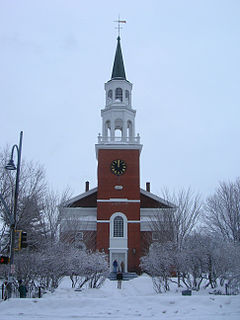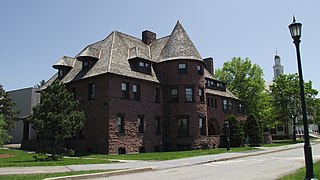
The First Baptist Church is a historic church located at 81 St. Paul Street in Burlington, Vermont. Built in 1864, it is a significant example of early Italianate ecclesiastical architecture in the state. It was designed by Boston architect John Stevens. The church was added to the National Register of Historic Places in 2001.

The Church Street Marketplace is an uncovered outdoor pedestrian shopping and dining mall in Burlington, Vermont, consisting of the four blocks of Church Street between Main and Pearl Streets. The mall was initially conceived in 1958 and was built in 1980-81 to a design by Carr, Lynch Associates of Cambridge, Massachusetts. It encompasses about 86 storefronts and is managed by the Church Street Marketplace Commission.
The following is a timeline of the history of the city of Burlington, Vermont, USA

Built in 1816, the Unitarian Universalist Meeting House is the oldest remaining place of worship established by white settlers in Burlington, Vermont. It is located along the northern side of the intersection of Pearl Street and the Church Street Marketplace.

The Burlington Traction Company is a historic trolley maintenance facility at Riverside Avenue and North Winooski Avenue in Burlington, Vermont. The property includes two brick trolley barns, built c. 1900 and c. 1910 respectively, that were used as public transit maintenance facilities until 1999, after which they were adaptively repurposed to other residential and commercial uses. The property was listed on the National Register of Historic Places in 2004.

The City Hall Park Historic District encompasses one of the central economic, civic, and public spaces of the city of Burlington, Vermont. Centered on City Hall Park, the area's architecture encapsulates the city's development from a frontier town to an urban commercial center. The district was listed on the National Register of Historic Places in 1983.

The Downtown Essex Junction Commercial Historic District encompasses the historically railroad-dominated portion of downtown Essex Junction, Vermont. Aligned along the south side of Railroad Avenue and adjacent portions of Main Street, the area underwent most of its development between 1900 and 1940, when Essex Junction served as a major regional railroad hub. The district was listed on the National Register of Historic Places in 2004.

The Ethan Allen Engine Company No. 4 is a historic former fire and police station at 135 Church Street in Burlington, Vermont. Built in 1887 for a private fire company, it is a fine local example of 19th-century commercial architecture. It served the city as a fire and police station until the 1960s, and is now used as a commercial space. It was listed on the National Register of Historic Places in 1971, and is a contributing property to the City Hall Park Historic District.

The William Fitzgerald Block is a historic mixed-use commercial and residential building at 57-63 North Champlain Street in Burlington, Vermont. Built about 1887, it is a well-preserved example of a period neighborhood store with residences above. It was listed on the National Register of Historic Places in 2012.

The Lakeside Development, or the Lakeside Historic District, encompasses a historic company-built residential development in southern Burlington, Vermont. Isolated between the Vermont Railway railroad line and Lake Champlain and accessible only via Lakeside Avenue off Pine Street, the area was developed between about 1894 and 1910 by the Queen City Cotton Company, whose mill complex stood just to the east of the railroad line. The district was listed on the National Register of Historic Places in 1982.

The Main Street–College Street Historic District encompasses a historically fashionable residential area of Burlington, Vermont. Principally located along Main and College Streets between South Winooski and South Williams Streets, the area was one of the city's most exclusive residential areas from the early 19th century to the early 20th century, and includes a diversity of high quality architecture from that period. It was listed on the National Register of Historic Places in 1988.

Moquin's Bakery, also known locally as the Biscuit Factory and the National Biscuit Company, is a historic former industrial facility at 78 Rose Street in Burlington, Vermont. Built in 1915 by a local bakery, it was acquired and enlarged by the National Biscuit Company, which operated here until 1969. The building was listed on the National Register of Historic Places in 1997 for its economic and commercial historic significance, and has since then been converted into residences.

The Porter Screen Company is a historic former industrial facility at 110 East Spring Street in Winooski, Vermont. Developed beginning 1910–11, this mill complex was an important secondary industrial employer in the city, shipping window screens and other housing parts nationwide. The facility, now converted to senior housing, was listed on the National Register of Historic Places in 1979.

Redstone is a historic former estate on South Prospect Street in Burlington, Vermont. It was developed in 1889, and includes some of Burlington's finest examples of Richardsonian Romanesque, Shingle, and Colonial Revival architecture. Its surviving elements are Redstone Green and some of its surrounding buildings on the campus of the University of Vermont, which acquired the property in 1921, and are part of the university's Redstone Campus. It was listed on the National Register of Historic Places in 1991 as the Redstone Historic District.

The University Green Historic District encompasses the central green and surrounding buildings of the main campus of the University of Vermont (UVM) in Burlington, Vermont. The green took shape in 1801, and has been a central element of the campus since then. It is flanked by some of the university's oldest and most architecturally important buildings, and was listed on the National Register of Historic Places in 1975.

The Edward Wells House is a historic house at 61 Summit Street in Burlington, Vermont. Built in 1891–92 for the president of a patent medicine maker, it is one of the city's finest examples of Queen Anne Victorian architecture executed in brick and stone. It was listed on the National Register of Historic Places in 1979. The house was for many years home to the Delta Psi fraternity; is now owned by the University of Vermont.

The Wells-Jackson Carriage House Complex is a well-preserved complex of estate outbuildings at 192-194 Jackson Court and 370 Maple Street in Burlington, Vermont, United States. Built in 1901 as part of a larger estate, the complex includes a carriage house, tack house, and coachman's quarters of a quality unrivaled in the state. Obsoleted by the advent of the automobile, the buildings have been converted to residential use. They were listed on the National Register of Historic Places in 1982.

The Winooski Block is a historic commercial building at 1 through 17 East Allen Street in downtown Winooski, Vermont. Built in 1867, it is the only major building to survive the city's urban renewal activities of the 1970s, and is a fine example of post-Civil War commercial architecture. It was listed on the National Register of Historic Places in 1974.

The H.C. White Company Mill Complex, is a historic industrial complex at 140 Water Street in North Bennington, Vermont. The White Company was founded in 1879, producing stereographic viewers and stereograph cards, as well as the Kiddie-Kar, a three-wheeled wooden scooter for children. These premises were occupied by the company from then until its closure in 1935. The complex, with buildings dating from 1887 to 1919, was listed on the National Register of Historic Places in 2017.

The Stannard House is a historic house at 3 George Street in Burlington, Vermont. Built about 1850, it is a good local example of Greek Revival architecture executed in brick. It was listed on the National Register of Historic Places in 2019. The building is now in mixed commercial-residential use..





















